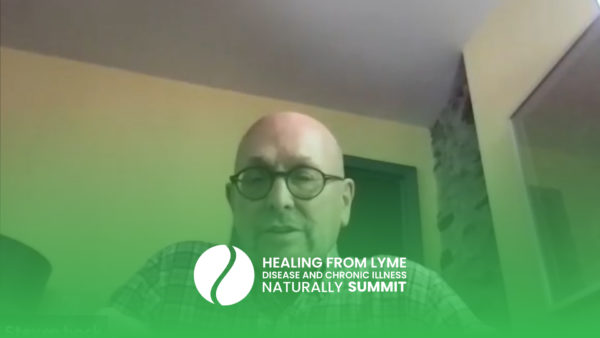Join the discussion below

Rob Besner, PSc.D, Co-Founder and Chief Science Officer of Therasage, has always been an advocate of natural health and wellness. Graduating from Boston University in Pre-Med, Engineering, Psychology and Business, he continued onto post graduate work at Case Western Medical School and Holistic Medicine After many years of illness, Mr.... Read More

Dr Scholz background is in science and research. He was previously associated with an international lab in Wisconsin heading the department of immunology, as well as overseeing their Research and Development wing. Felix has received numerous awards and grants from the University of Kiel and the University of Minnesota as well... Read More
- Immune responses to tick borne pathogens.
- T-cell signatures to tick borne pathogens.
- Making sense of T-cell signature in complex illnesses.
Related Topics
Chronic IllnessRobby Besner PSc.D.
Hey everybody, welcome back to another amazing interview this time with Dr. Felix Scholz from the infectolab-americas.com is the way you can find him, but he’s got an amazing background. And this is such an important topic for us to cover because if you don’t have the proper testing, then you can’t make the right diagnosis. And if you don’t have the right diagnosis, then you don’t have the right treatment plan. And so there’s actually some fuzzy logic to all of this. And as most of you guys out there have already known or experienced, Lyme is a very funny kind of disease and it mimics many other diseases, neurological diseases and so forth like MS and Parkinson’s and so forth.
And so because it mimics other diseases in its symptoms, the way the body expresses it, that’s why having a proper lab doing a good test that’s got great results is so important. And so I’d love to introduce Dr. Felix today, he’s well-read, he’s well-researched, he’s published, he’s gotten public grants, he brings over wisdom and knowledge that is just from central Europe. The way that Europeans look at healthcare is very different than the Western approach, plus they have a lot more tools available to them and they have more flexibility in their own researches that gives them kind of a leg up in certain areas and so he brings a lot of that European flavor to his way of expressing himself in his current position. So with that I wanna introduce Dr. Felix to the group, welcome to the Summit and give us a couple of minutes, just on a little bit of your background, why you got started in immunology and then walk us forward to where you are today.
Felix Scholz, PhD
Thank you so much for the kind introduction and I really appreciate the opportunity to be partaking in this event. Yeah so I studied Biology and I was always curious about Biology and Biological Science, and I studied that with an emphasis on Genetics, Neuroscience and Development Biology and afterwards for my PhD, I switched into basically Innate Dermatology Research so I did like skin infections, skin irritation research for my PhD. And from there I went for brief post-docs in the Mayo Clinic and later on for a longer time to the University of Minnesota Center for Immunology where I then ended up doing a lot of bacterial infection and microbiome research and it’s just an amazing field, immunology is very complex.
Immune cells come in all different types of flavors. And I just by that and Americas, a few years ago at the conference and we just thought it’s a good fit she had an idea for lab and to technique. And I came from a company where we had a developmental team for lab tests. So basically our core team here at Infectolab Americas used to develop four different companies, license full psychometric essays. So we have a great expertise on all levels of the companies and which I think is important to ensure proper quality, because you can trust us with your samples because we know what we’re doing. It’s not like ending up in the random lab automation or whatever. So we try to take care of things and be very involved in making sure we can provide good quality.
Robby Besner PSc.D.
Well, that’s certainly super important. And living through the night, mayor of all the other testing services that were out there before, and I go back 25 to 30 years. So back then there really weren’t that many other labs available to go to, but the amount of false negatives and what’s kind of very unique about this Lyme disease or tick-borne disease. By the time you actually test it actually shows up in your bloodstream it’s actually too late to actually treat it with certain kinds of antibiotics that could actually knock a lot of the infection or potential harm that Lyme can do to your body out beforehand.
So it’s sort of a catch 22, you have these testing service, but besides the fact that there are so many false negatives that are produced by the labs, just the inaccuracy of lab testing in general, often poses a problem within itself. So that even dials in what you’re doing to be even that much more important to the community out there to find out exactly what is going on and in different phases, it could be for early treatment, it could be while you’re in treatment, to understand exactly how your body is responding to treatment. And all of these things are important because there’s oftentimes a lag between the treatment plan and the way your body responds and certainly with different kinds of symptoms and then to make things even more complicated, everybody’s genetic dispositions are different.
And so each of our bodies interpret the various different kinds of toxicities and the way the immune responses of the bodies, it changes from person to person. And so again, it brings us back to you. It’s like all roads lead to Rome here, Felix, it’s so important to have a really good diagnostic team. One that is consistent and certainly one that has the interest in always dialing up the technology to have the latest and greatest kinds of ways and testing services out there. So with that, let’s dive into a little bit about the immune response. What is a T cell anyway? We’ve heard so much about killer cells and T cells and immune responses and all that. Explain to everybody out there that’s just tuning in what that means.
Felix Scholz, PhD
Okay, you can divide the immune system and move into rough branches. So as I mentioned, the production, I started off with innate immunity. That is just a type of immunity that we are born with basically it’s cells that belong to different types of tissues can be skin, can be lung, gut, can be immune cells that have receptors on them that can just detect certain molecules that are alarm signals basically. So they can sense something’s not right. Here’s something that should be here and bring the alarm bell, they often cannot necessarily clear the infection in some cases it can and some it can’t, that would be the innate immune system.
It’s very rough, very broad strokes and it can do some stuff, but not everything. And that usually entails starting the lab system, which often so called cytokines that activate the adaptive immune system. And the adaptive immune system you can divide again in two big branches, that is the B cell and the T cell response. And each of these branches goes down in multiple product. So it’s a very intricate and very complex machinery that intertwines with each other and it’s very fun too. And as you mentioned, like so T cell- Yep, so, T-cell is from the adoptive branch that has generically made and the thymus checked for self. Like if a T-cell detects self usually it gets depleted.
And then as a naive T-cell homes around this human body, and there’s one specific receptor where it never knows if it ever encounter what the receptor can match. And now if he has an infection or some other cells in the periphery so-called dendritic cells or antigen presenting cells would take like a bidding brick of a pathogen and going through the and there we’ll show what they’ve seen to T cells that never have seen the antigens. So not some naive T cells that have never been activated. So we have billions of these cells circling around with generic specificity. And then if the event happens that these one generic T- cell matches it gets activated and sees and response. So it would be activated and start the so called clonal expansion meaning out of this one T-cell there will be hundreds or thousands, depending on the sickness, what type of T-cell it will be and the antigen like how they interact between antigen epithelial cells and the antigen is very complex, very intricate.
It can be very different from antigen to antigen or disease to disease. So now these T cells then have very specific functions like we have hepa cells that are mixture of cells with mixed functions. Like some of them have B cells that antibodies, some of them home to the periphery and go through the infection inflammed site and basically spawn more infection or inflammation Not a text, sorry. Inflammation and call it like other fighters like rubicites, macrophages and neutrophils, whatever it goes and K cells to fight, right? So these that themselves cannot kill necessarily bacteria.
There’s a different subsets that can do that. And then you have later on an infection what’s called memory response. So basically the immune system can feel infection gets better, immune system does what it’s supposed to do. Infection goes down. So inflammation goes down and then the immune system brings memory T cells So the same one antigen gets experienced by different T cells at site. And then it went on the down slope of an infection, this T-cell will be told you become a memory T cell. And that memory T-cell will do the same things on some more cells and then home would to the tissue and after everything is done will staying into the tissue. And that also depends on the antigen, what type of pathogen. So the location where it goes to is determined by that.
So if it can enter the skin or the gut or the lung, and there these cells can be without antigenic exposure, multiplying for a few years or a few months, it really on the infection, some infection you have protection only for a few weeks, some you will have for a few months and some 40 years to come really depends. It’s not like a generic answer that, “Oh, I experienced one infection, now I’m good for my life.” That is not true. Really depends on what’s going on. So T cells are involved at these different steps and the beauty of like what we do with T-cell testing for example, is that we can actually check in during this different time stages of infection. And then it really depends on what we see where it has come from, what it can deduct in lung for example, what stage are you in like are you in an adjuvant section or is it reactivation, or is it a chronic condition? Or for example, after a few months of treatment, did the treatment work? Like you can check for the way we test for two different types of T cells, the T 20 cells, which are the fighters and the central memory T cells which are found in the bloodstream for a few months after infection or at the end time of the infection or after the infection. So you can see basically how these to develop and get a feeling for where you at during an infection.
Robby Besner PSc.D.
Wow, this is so important, what you’ve just said. So I just wanna kind of compress it and make it a little bit simpler. So it’s kinda like the art of war. You have these- By the way, everything that Dr. Felix has been describing we are not thinking about this, this is just automatic systems that our bodies- We’ve been blessed to be given to us. And so we have this system of sort of soldiers that go out like the Indians scout or the scouts that go out.
So these cells go out and they kind of identify and tag what they would consider to be foreign bodies of virus or bacteria, or parasite, whatever foreign to what it’s the body’s own definition of what it knows to be itself. And so the first part is identifying these cells, these T cells, or a scout cells, they go out and they identify that there’s an invader. And then they come back and they report that information to the body of which the body starts to create the soldiers to go out to attack and defend the body, or hold up the body’s integrity, the immune system, to be able to each curtail the advance or the replication of this particular parasite or virus, or in this case, we’re talking about Lyme or the co-infections that often travel with Lyme like Bartonella or Babesia. And this is so important for people to understand, because it’s all done. You’re not asked to do any of this. It’s all being done automatically. The part that gets tricky is when you have what’s called an auto-immune response, where these cells get confused and they come back with confusing information, but that’s where your diagnostic comes into play. It’s why that’s so important. And what I really love that you said just recently was about that your testing service can actually give us degregations or degrees of how you’re progressing either.
If you’re going down and things are getting worse, we can figure that out. If you’re doing some kind of treatment plan and you’re getting results before they even show up and you feeling better in your body, less symptoms, we can actually do a test and we can say that the type of treatment plan that you’re on is actually doing good for you and supporting your natural immune system and getting you back on track to good health. So I think that all of these things are so important for people to understand. And then the last part of what you said about the adaptive aspect and that these cells also have memory, they bring back and communicate to each other, the information about the foreign invader and these guys, the troopers, they hang out there and they go, “Okay, well, we got rid of the problem right now, but we’re gonna make sure that we remember.
So if they actually come back then we’re gonna be able to identify and really pounce on this and bring out the troops and get this under control.” So I think that all of this is so important for people to understand because the immune system is complicated and we know that things suppress our immune system, like stress on the body and things like that, emotional or physical stress, but we don’t quite understand how that works. And so understanding the role that all these cells play with one another and their relationships in reporting and maintaining the integrity of the immune system, I think you’ve really simplified that explanation. Thank you.
Felix Scholz, PhD
Yeah and then obviously there’s also B cells which produce the antibodies and what is required for that, is called t follicular helper that are crucial for doing a proper class, which 2 IgG and also to create during affinity maturation is the process with B cells wants to make each one the better antibody. And so what’s important there to understand with Lyme is that there’s papers out there for mice, that show that specifically, that process the lymph node is attacked in certain Lyme infections. Meaning that is probably one of the reasons why we see so many false negatives in serology testing. It’s not the fault of the other labs or the technology is not working properly. The issue is in the biology of the buck, right? We have to keep that in mind.
I mean, obviously that doesn’t help with the diagnostics. If the antibodies are not properly formed in infected people they’re not there. So with that technique, it’s hard to measure, but I think it’s not the issue of serology I think the issue is of the biology of the bug, because the bug interferes with the steps of forming a proper antibody response, okay? And it can also interfere sometimes with T-cell responses, but it’s not as common. So that’s why T-cell testing has a little edge on the anti bony detection. And obviously what we also see is that once people start treating, we see usually a spike in T cells. And the reason for that is so the T cell frequency depends on how much exposure to a bacterium they have. And you have the issue that Borrelia is a very slow dividing back. So it divides I think 24 to 48 hours if I’m not mistaken and put it in this perspective, E.Coli divides under optimum conditions in 20 minutes. So you can see that’s a huge difference in the speed of replication of the buck. And that obviously limits what an immune system can see. Like the immune system just doesn’t have a lot of antigens or material to show to the immune system that may play a role too while the immune response is so weak.
Robby Besner PSc.D.
The slower the replication, the longer it takes for the body to recognize that there’s a foreign invader, right?
Felix Scholz, PhD
That maybe it’s just less around. Like if you have, let’s say a hundred molecules from a different infectious disease, 10,000 molecules to see for the immune system that triggers probably more alarm, if you have more available than less. And I think that may play a role too why antibody response is lacking, right? Because you have low amount. And secondly, then sometimes the bacteria can actually interfere with the critical step of forming proper IgG. So you have like these two issues at hand, and we see that with the T cell frequency too. So our test is not the magic bullet, right? We see that too, that people that have little bacteria burn don’t have a lot of T cells to measure.
But what we see too post treatment, if people check in with our test again, we see higher T-cell amounts. And the reason for that is that if you now has a few bugs, but you kill them, suddenly there’s more antigen available T cells seem more and then you have more cell division and hence you get more T cells so actually seen every now and then that is like, let’s say, if you get checked and you barely have T cells and then you get treated three months later, you get checked and you have skyrocketing T cells, that’s not necessarily means for concern. It just probably means the treatment is working. You have to be careful with specifics also in the context of all that testing. It’s like- Yes.
Robby Besner PSc.D.
No, I’m sorry. I didn’t mean to cut you off and we’ll cut this out. So what’s really interesting what you just said, because you could get the feeling like if your T-cell goes up at post treatment, you could think that, wow! The treatment is not working because you’re actually got a higher T-cell count suggesting that you might have more active disease or Lyme when it’s actually not really the case, and in fact, the treatment plan might be working well, but because we knocked out some of that Lyme, it actually released more of the serum that the body is focusing on to bring out more T cells. And so what really is important is for the patient to tell or to know when they’re doing the test or when the test is being sequenced, in fact that they’ve done some kind of intervention that might be important for them to understand or shade the result from your test.
Felix Scholz, PhD
It’s always good to keep in mind. And especially always generally speaking, not only with our tests in general, it’s often good practice to keep the symptoms that are currently present in mind when you do a lab test because the lab test alone is not necessarily a solution, right? And then for example if after three months the symptoms prove and everything’s gone fine, where the T cells are higher than previous, that probably just means it works. But again, specifics at the time point and the guidance from the doctor is I think very, very important here ’cause it’s a complex disease. And our test is sometimes also not that simple to interpret because there is a lot of information into understand that appropriately and based off proper decisions, I think.
Robby Besner PSc.D.
Okay, so let’s get into some of the practical parts. Like I wanna get tested. Is it super expensive? How quickly can I get a result? Do I have to go to a lab and have blood drawn and then send it out to you? Tell me how that part works?
Felix Scholz, PhD
Okay, so first we prefer to work with doctors in clinics, or we usually have people goes through the doctor, the doctor can just order kits, we ship out the kits. These days we also do a lot of one of our customer says, I have a patient that doesn’t wanna come into the office, we ship them directly. We have also information and all that page four for lobotomy services. So that is easy for people to find information and know where to draw blood. I mean, it requires a blood draw.
Yeah, the kit we sent out has everything instructions, all the troops required entered prepaid overnight shipment for living say testing, it’s utmost important that the cells arrive at the shortest time period between blood draw and processing, right? Because you can imagine cells of necessarily a heavy in a blood draw. So once they come in the morning, usually arrive at our place. We try to get them all then off as quick as we can and getting them on the plates in proper medium, with proper life factors they need. And so that’s why we do overnight shipment in the US the are perfectly from each spot you send it. So it’s very similar to set us up and get-
Robby Besner PSc.D.
So you wanna really do the test like on a Monday or a Tuesday. So you have Tuesday, Wednesday, Thursday to deliver it to the lab. You really don’t wanna do the test on Friday so that it may not get to your lab until Monday or Tuesday the following week.
Felix Scholz, PhD
Yeah, sorry we do overnight shipment. So Friday blood draws don’t work anyway. So blood draws Monday through Thursday. And if you do it on Monday, you probably have the results already on Friday. So because blood draw Monday shipment overnight, Tuesday morning, in our lab, then the test it’s like we incubate over night. Like we simulate basically the in lymph flow in the cell culture distributive tubule like we take the cells, everything required for any antigen presentation is in there. We expose them to Lyme antigens or disease antigens. Or else its ordered. You give them 20 hours, the T cells to respond. And then and we wash the cells away and stain for the readout system and then the plate dries. And on the third day we have the results. And usually the report goes home. Very, very smooth, quick process with us.
Robby Besner PSc.D.
Well, that’s super, super quick,
Felix Scholz, PhD
Yes it is.
Robby Besner PSc.D.
Certainly when you’re not feeling well or you’re- Yeah and you don’t know what’s going on to know that within a week, you could actually rule out or rule in the possibility of Lyme and any of the co-infections. That’s amazing. So you go through your practitioner, they order up the kit, then you can either deliver it direct to the lab, or you can go to the clinic or come to the person’s home. Then they do the test, they send it to you within a few days you already have a result. And now, because sometimes there’s an incubation period for the Lyme to show up Is there, if you don’t have the classical situation where you’ve found a tick on your body, let’s say, or you’ve seen a bullseye rash, you know, there’s many different kinds of symptoms.
People some times they get a fever or they have a histamine response almost right away, sometimes not at all. So because there’s such a great variance there, do you find that you’re the consistency on your reporting and the results irregardless of whether the body immune system kicks in or not, or you’re symptomatic or not, when you come out at the other end of the tunnel from your experience, is there enough consistency in your testing that you can capture a huge part of the potential diagnosis or at least, understanding from the test?
Felix Scholz, PhD
Yes, I believe so. I mean what it requires is obviously the T cells to see enough antigen. I think most of our doctors sent in from more chronic patients, right? I think we barely have acute patients. So if you have just had today a tick bite, it doesn’t make sense to use all tests, right? Then you need to wait at least I would say six to 10 days to have a proper wound response and actually something you can measure, right? With chronic patients, it’s sometimes a little bit tricky, and then it really depends on what’s going on in the patient, right? The tricky part is there that in chronic patients sometimes there is not so much the spiral kits in the body that elicitates a really good immune response. And they are sometimes I would say our test also a little bit of detection. So we see that sometimes too but people come or negative and post treatment, what I touched on earlier, they put up positive. So we see that too. It’s not like, again, as I said, it’s not like the perfect test, and I think the perfect test doesn’t exist in Lyme because of the biology that can’t stop. Because if it enters the immune system it enters the immune system, right. And then it’s just- I think that the T cells you have just the advantage of following up and monitoring the response. And I think that’s where the great span of the test is, I mean, then there’s also direct testing of PCR. And I think that is also very limited, not because of the technique, because PCR is a very accurate method.
I think you should here for the direct method like that, you require the DNA of Borrelia and the blood. And again, like you have only a few bacteria in the body and those are not living in the blood. So, you require is some “death toll” if you so will of the bacteria to shed DNA into the blood and then be visible by PCR. And that’s just highly unlikely. That’s why statistics show that PCRs like 30% of Lyme patients get tested positive with that. That’s probably been during time of dissemination or bolts of disease, that well be at a high bacteria burden point. And so that’s the thing with the different tests for Lyme that I think, yeah, they’re all have there some disadvantages in that license and the biology of the bacteria.
Robby Besner PSc.D.
You have the biology of the individual, and then you have the biology of the Lyme itself that also is changing. And that interaction that makes it a little bit more complex. So let’s just shift a little bit and talk about there are other testing services out there. as I mentioned earlier, you bring to the table something very unique because you’ve had the European experience and the latitude or the flexibility to really go into areas of research that in America we haven’t quite gotten to certain areas or we have, but it’s just not been able to been perfected to bring to the public as of yet. So tell us a little bit about what makes you different in either your approach or your results, or, you know why should our Lyme community come to your testing service?
Felix Scholz, PhD
Okay, so some of the T cell testing or ELISpot testing is not a another technique. So the technique has been in Immunological Research around for roughly around 40, 35 years. And so Immunologists use this like to identify immunogenic peptides research or whatever. So it’s a very common technique. And in diagnostics, I think the first usage was in the early 90’s in Europe for Cytomegalovirus and Epstein-Barr virus, where they checked pre-transplant, liver transplant patients for seeing if there’s a potential of reactivation of these viruses, because we know with chronic fatigue and other stuff, these viruses can wreak some havoc, right?
Robby Besner PSc.D.
Sure.
Felix Scholz, PhD
And now you think of somebody getting a liver transplant and the immune suppressive drugs that are required to survive transplant, you can send a CD40 cells IQ required usually to maintain EBV and CMV and create sense in human body, right? So now you take the immuno suppressive drugs, somewhat the capacity of the T cells away to a limit bio replication. So we can see with this test pre-transplant if you have a chance of reactivation actually. So check for specific antigens and we opt for the T cell frequencies that are T cell frequency where they are, they would give the transplant patient right away, some antivirus to keep EBV and CMV in check.
So that’s actually 30 years ago where the first usage of diagnostics was used of these T-cell tests. And then later on, they ventured out and I think there’s like tuberculosis that is available in the US as well because you know Tuberculosis has a similar issue like EBV and CMV, it can be chronic controlled and spur up. And the T cell frequencies, basically, you just monitor what’s going on. Like, is it quiet? Is it not quite? And that’s what we do actually. And the level we are on to is that most labs- I know other labs doing that. Most labs use only interferon gamma as a readout, which is antigen specific to H1 T cells. So we also look for I2 to producers.
So antigen specific I2 producers in the blood. Those are a central memory T cells and the idea of that is that that’s on another layer of knowledge, because now you can monitor how TH1 or the central memory response moves, right? Because usually you have tutored sectional reactivation Mostly T20 cells then there’s a step better than I2 T Cells, should come up, but they only come up for a brief time period sometimes you miss them.
If your measuring spots are too short, sorry, too long. But that’s the uniqueness of us in addition, that we have the antigen specific T-cell type, which adds another level of information. And as we do test for Lyme, we also check for all the core sections and we also have like a nice vibrant portfolio. And I think that you can also see like that, how different diseases are, right? For the immune system in response of how they can deal with it, right? Like some diseases other diseases it can’t, right? And in viral infections, the interesting part for me is to see, that usually T cells frequencies against the antigens are way higher because the viruses are against bacteria. And again, like for chronic fatigue, especially also in Lyme or without Lyme there’s a nice portfolio for HHV6 EBV CMV as well. But we can look at all the different subsets of T cells and get a feeling for is it chronic control or is it reactivate.
Robby Besner PSc.D.
So you turn around in a quick time frame within a week, couple of three days a week, you have an amazing delivery system. You have multiple layers of ways that you look and analyze the body’s response so that you can actually degregate or show degrees of concentration of disease either going up or coming down so that people can kind of get a feel for where you are on your healing journey. How about the expense? Are you as expensive as the other systems? Are you less expensive than some of your competitors? Are you’re right in the middle?
Felix Scholz, PhD
I think that we have fairly decent price. I think we are fairly- I don’t know if its cheap but I think we’re good realm. Like the single tests one antigen runs between like 160 and $290, depending on which antigen that is. And then we have bundles where we also have discounts because you ship only once. So those costs are covered by the first antigen test. So we cost in the pricing independence for four different packages, varying between 500 and a thousand bucks, I think. Sure, it’s fairly okay.
Robby Besner PSc.D.
Which makes way sense ’cause the packages or the bundles will create more comprehensive result or at least more information for the clinician and the patient to understand the process. But I just remembered 25 years ago, our blood testing or the testing that we were doing, were in the thousands of dollars each test, and the results weren’t clearly as conclusive as what you described today. And so aside from just the advancements and the dialing in and the ability to actually analyze, the efficiencies and the economies of scale, bring the pricing down, has made it way more affordable. And that allows the patient and both the clinician to be able to test more over different periods of time.
So you can actually get better snapshots, which gives both the patient and the doctor a better feel for the tapestry of how the body is responding. And that, of course is super important for us to dial in the proper diagnosis and the proper treatment plan, right? And the aftercare, these are all this stuff is super important, but if you don’t start off with a good test and a reliable group that you can work with, that cares about what they’re doing, you know, really is working hard, not just to make sure that they’re doing the best they can do today, but is constantly dialing up the advancements in this area of immunology and the ability to do good testing, good quality testing, consistent testing and make those services available. This is so super important. So I love you for being on and participating today. Your information was super important. We only have a few minutes left today on our discussions. So I just wanted to give you the opportunity if there’s something that I didn’t cover, if there’s some information that you feel is important for people to know Dr. Scholz, can you relate to us and the people out there some last words.
Felix Scholz, PhD
Okay. Yeah, I think we touched most important topics and I think we covered them fairly okay or well, and I really appreciate this opportunity and thank you so much for inviting me for this talk and yeah. Thank you so much.
Robby Besner PSc.D.
You’re welcome. All right, so you can get to Dr. Scholz, Dr. Felix Scholz and his company it’s called Infectolab. You can go on the internet, you can find it Infectolab, which is I-N-F-E-C-T-O-L-A-B hyphen Americas, A-M-E-R-I-C-A-S.com. Is there a phone number or? That’s the website, but is there an email that people send to you or what are other ways?
Felix Scholz, PhD
Yeah. The email is just [email protected] And the phone number is- one second. The phone number is 651-387-2614, yeah.
Robby Besner PSc.D.
It’s funny that you had look for your number because I very rarely call myself. So I’m always going, “Oh my God, what is my 800 number?”
Felix Scholz, PhD
It’s also not mine. I mean, it’s the lab number, right?
Robby Besner PSc.D.
Of course, of course well, anyway doctor, thank you so much for bringing your expertise to America, to the lab, the advancements it’s so super important for all of us to know about you and to know the work that’s being done in your area, because without the proper testing, we are really kind of shooting in the dark and it’s really super important what you do, and I’m really happy for your contribution. And I’m really super, super excited to have people understand this and get a chance to meet you and the work that you’re doing on our Summit.
Felix Scholz, PhD
Yes, thank you so much again.
Robby Besner PSc.D.
Hey everybody, it’s Robbie Bessner thanks so much for joining us today. Please share this content with anyone that you think might benefit from it. And we’re looking forward to having you with us tomorrow for another great interview.
Downloads










